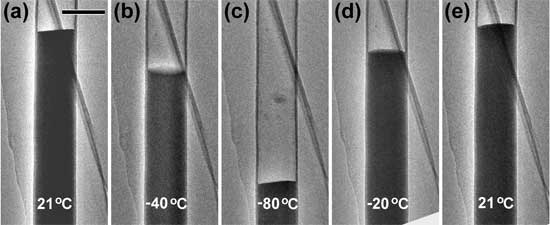| Posted: Jul 20, 2006 | |
Carbon nanotube nanothermometers |
|
| (Nanowerk Spotlight) The oxidation-assisted temperature measurement with carbon nanotube nanothermometers that contain liquid gallium is a novel and reliable method that can be used over a moderate temperature range and can be applied in any environment where air is present. All the other available techniques that are capable to measure temperature at the nanometer scale are limited by either that they are only workable in a very narrow temperature range or that they can only be applied in a special environment. | |
| One particular problem to arise from both the continuing miniaturization of existing technologies and the advent of nanotechnologies is that conventional devices for temperature measurements, such as thermometers and thermocouples, are not capable of measuring the temperatures of these systems at the scale on which they operate. Thus, a pressing scientific problem is the need for a viable technique for measuring temperature at the nanoscale. | |
| A previous approach in using carbon nanothermometers focused on a single nanothermometer and involved preliminary calibration in a transmission electron microscope (TEM) to record the initial level of the liquid Ga. The complexity of this approach is that the same nanothermometer needs to be found again after use to make the final reading in a TEM. | |
| In a novel approach, researchers at the NANO Major National Research Facility based in theAustralian Key Centre for Microscopy and Microanalysis at the University of Sydney, and the Advanced Materials Laboratory at the National Institute for Materials Science in Japan, came up with a one-step procedure without the need for any calibration process. It provides a simpler and, importantly, a far more reliable way to measure temperatures over a moderate temperature range at the nanometer scale. | |
| When a Ga-filled carbon nanotube is heated in air for an appropriate length of time, an oxide marker is formed on the inner wall of the carbon nanotube due to partial oxidation of the Ga. Thus, the temperature to which the nanotube was exposed can be retrieved by progressively heating the carbon nanotube until the liquid Ga reaches the oxide marker. | |
 | |
| TEM images of a carbon nanotube confined with Ga at different temperatures. (a) was taken at room temperature; (b) was taken at -40° Celsius; (c) was taken at -80° Celsius and the confined Ga was solidified at this temperature; (d) was taken -20° Celsius and the solid Ga was melted at this temperature; (f) was taken at room temperature. Scale bar = 100nm. (Source: Zongwen Liu, University of Sydney) | |
| "The oxidation-assisted temperature measurement provides us an effective way for measuring temperatures that is not possible by other means" Zongwen Liu explains to Nanowerk. "It greatly simplifies the previous method that involved an initial calibration of the nanothermometer and then final temperature estimation based on the volumetric expansion of the Ga. This novel method is expected to have broad applications in nanotechnology and in engineering fields such as microelectronics and fuel cell research." | |
| Liu is first author of a recent paper titled "A novel method for practical temperature measurement with carbon nanotube nanothermometers", published in the June 27, 2006 online issue (print issue: August 14, 2006) of Nanotechnology. | |
| "The current oxidation-assisted temperature measurements with carbon nanotube nanothermometers are expected to have potential applications in industry especially the electronic industry" says Liu. "Unexpected changes in temperature can often be the first signs of failure in electronic devices. In fact close to three quarters of all failures is because of thermal overload." | |
| Temperature measurement in electronic components is critical as temperatures outside their working range might damage the electronic circuitry. Thermistors and digital sensors have been predominantly used for temperature sensing in electronics. The trend towards miniaturization means that the heat is only generated over a very small area. The traditionally used techniques will no longer be capable of measuring temperatures of the future electronic devices. | |
| Liu explains that the results reported in the Nanotechnology paper have proven the nanothermometer as a practical concept, but further science must be done to make it an easily applied nanotechnology. | |
| "Under simple experimental conditions, our method accurately records the temperature to which the nanotubes are exposed" says Liu. "When nanothermometers are heated in air, the oxidation of the confined Ga is affected by temperature, time, and, we expect, nanotube diameter. Efficient implementation of the oxidation-assisted temperature recording technique requires that we better understand the oxidation behavior of Ga confined in carbon nanotubes." | |
| In previous work ("Unusual Freezing and Melting of Gallium Encapsulated in Carbon Nanotubes"), Liu and his colleagues showed that when Ga is encapsulated in carbon nanotubes it remains liquid down to either ?70° or ?80° Celsius, depending on the phase formed during solidification. So theoretically the carbon nanotubes that contain Ga can be used to measure temperatures as low as -70° Celsius, but it needs a way to read the nanothermometer for low temperature measurements. The present oxidation-assisted temperature measurement is only effective for temperatures that are above room temperature. | |
 By
Michael
Berger
– Michael is author of three books by the Royal Society of Chemistry:
Nano-Society: Pushing the Boundaries of Technology,
Nanotechnology: The Future is Tiny, and
Nanoengineering: The Skills and Tools Making Technology Invisible
Copyright ©
Nanowerk LLC
By
Michael
Berger
– Michael is author of three books by the Royal Society of Chemistry:
Nano-Society: Pushing the Boundaries of Technology,
Nanotechnology: The Future is Tiny, and
Nanoengineering: The Skills and Tools Making Technology Invisible
Copyright ©
Nanowerk LLC
|
Become a Spotlight guest author! Join our large and growing group of guest contributors. Have you just published a scientific paper or have other exciting developments to share with the nanotechnology community? Here is how to publish on nanowerk.com.
